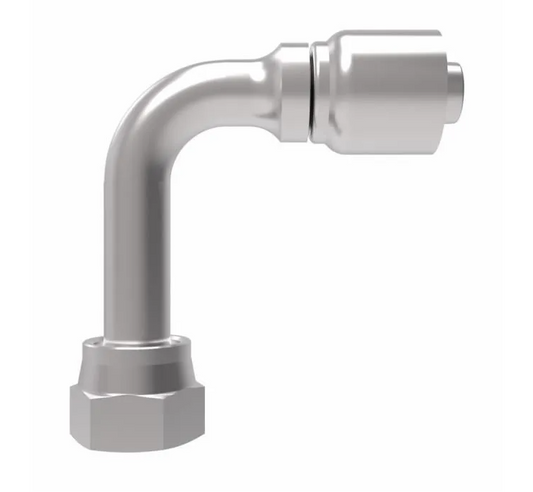-
37 DEGREE FEMALE JIC SWIVEL
Prix habituel Du $6.57 USDPrix habituelPrix unitaire / par$3.42 USDPrix promotionnel Du $6.57 USD -
JIC Female (37 ˚Swivel), TUBE-Elbow 90˚
Prix habituel Du $12.47 USDPrix habituelPrix unitaire / par -
37 DEGREE FEMALE JIC SWIVEL LONG DROP 90 DEGREE
Prix habituel Du $10.06 USDPrix habituelPrix unitaire / par -
FEMALE 90 DEG BENT TUBE SWIVEL
Prix habituel $19.00 USDPrix habituelPrix unitaire / par -
37 DEG. FEMALE JIC SWIVEL 45 DEG. BENT TUBE
Prix habituel Du $12.00 USDPrix habituelPrix unitaire / par -
En vente
37 DEGREE JIC MALE RIGID
Prix habituel Du $6.09 USDPrix habituelPrix unitaire / par$19.68 USDPrix promotionnel Du $6.09 USDEn vente -
SAE 45˚ Female Swivel, Straight
Prix habituel Du $5.11 USDPrix habituelPrix unitaire / par
37 & 45 Degree JIC Fittings - Hydraulic Fittings FAQs
Contenu réductible
1. What are 45 degree hydraulic fittings?
45 degree hydraulic fittings feature a 45-degree bend, which allows for more compact routing of hydraulic hoses and helps reduce strain on the hose connections, it is mostly used in hydraulic implementations.
2. What are the advantages of using 45 degree hydraulic fittings?
They offer a compact design that allows for tighter installations, better flow characteristics compared to other models, and reduced stress on the hose connections, which can extend the life of the hydraulic system where it is implemented.
3. How do I properly install 45 degree hydraulic fittings?
To install 45 degree hydraulic fittings, first, ensure that the threads on both the fitting and the mating component are clean and undamaged, use a sealant or tape to the male threads, and be careful to not contaminate the hydraulic system. To finalize, thread the fitting onto the mating component by hand until snug, and use a wrench to tighten it to the recommended torque value, ensuring a proper seal without over-tightening.
4. Can 45 degree hydraulic fittings be used with different types of hoses?
Yes, 45 degree hydraulic fittings are compatible with various types of hydraulic hoses, including rubber, thermoplastic, and other materials. However, it's essential to ensure that the hose and fitting sizes match and that the hose is rated for the operating pressure and temperature of the hydraulic system.
5. What are 37 degree JIC fittings?
JIC fittings are a type of hydraulic fitting with a 37-degree flare angle on the end of the tubing or hose. They are widely used in hydraulic systems, mobile equipment, and other applications where reliable sealing and vibration resistance are a must.
6. What are the benefits of using 37 degree JIC fittings?
They are easy to assemble and disassemble, they also offer a reliable sealing even in high-pressure and vibration environments, and last but not least compatibility with a wide range of hydraulic components while ensuring consistent performance and quality.
7. How do I properly install 37 & 45 Degree JIC Fittings?
To install any of them, first, ensure that the threads on both the fitting and the mating component are clean and undamaged, use a sealant or tape to the male threads, and be careful to not contaminate the hydraulic system. To finalize, thread the fitting onto the mating component by hand until snug, and use a wrench to tighten it to the recommended torque value, ensuring a proper seal without over-tightening.
8. Can 37 degree JIC fittings be reused?
JIC fittings are generally reusable, but it's essential to inspect the flare and threads for any damage or wear before reinstallation. If the flare or threads are damaged, the fitting should be replaced to ensure proper sealing and prevent leaks.
9. What materials are 37 & 45 Degree JIC Fittings made from?
JIC fittings are available in various materials, including carbon steel, stainless steel, and brass. The choice of material depends on factors like compatibility with the hydraulic fluid, corrosion resistance, and cost considerations.
10. Are 37 degree JIC fittings interchangeable with other types of fittings?
JIC fittings are not directly interchangeable with other types of hydraulic fittings, such as NPT (National Pipe Thread) or BSP (British Standard Pipe) fittings, due to differences in thread design and sealing mechanisms. Nonetheless, adapters are available to connect JIC fittings to other types of fittings if necessary.
11. How do I identify the size of a 37 degree JIC fitting?
JIC fittings are sized based on the outside diameter of the tubing or hose they are designed to connect. The size is typically marked on the fitting itself, using a standardized code that indicates the dash size (e.g., -4, -6, -8, etc.).
12. What are common applications for 37 degree JIC fittings?
JIC fittings are widely used in various applications, including hydraulic systems for mobile equipment (e.g., construction machinery, agricultural equipment), industrial machinery, and automotive applications, among others. They are particularly well-suited for applications that involve vibration, high pressure, and temperature fluctuations.







